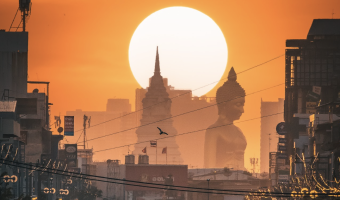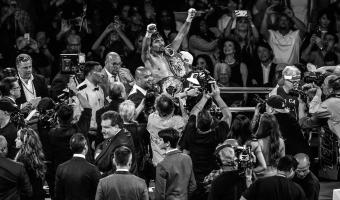Suburban Chinatown
Suburban Chinatown is part of an ongoing body of work by photographer, Jessica Chou that explores daily life in a cluster of majority-Asian suburbs in the San Gabriel Valley, a ten-minute drive east of Los Angeles.
Chou grew up in Monterey Park, the first U.S. city to reach a majority Asian-descent population by 1990 and labelled “the first suburban Chinatown” by sociologist Timothy Fong. While Chou found her upbringing to be typical of a suburban lifestyle, it was apparent that “my relationships and my interior life were drastically different from the lives I read about in books or watched on television, which reflected an idealized white suburbia.”
Despite the integral role Asian immigrants have played in the history of Southern California, their contributions and tribulations are often absent from mainstream accounts. Southern California owes much of its formative infrastructure, agriculture and economy to Asian pioneers, in particular the Chinese, who began to settle en masse after the discovery of gold in 1848.
The San Gabriel Valley remained a predominantly white region until the 1970s, whereby the Immigration and Naturalization Act of 1965 abolished the quota system based on national origin, a residual policy of the previous Exclusion Acts. Today the San Gabriel Valley is one of the most ethnically diverse regions in the United States and more than a quarter of the population are Asian American. According to the 2010 census, the largest populations of Asian Americans are Chinese, Filipino, Vietnamese, Korean, Taiwanese and Japanese.
Through this series, which began in 2013, Chou grapples with the notion of the suburban landscape and how immigrant communities fit into that narrative. Chou poses questions such as how does the narrative of the California ethos, the suburbs and the American Dream take shape within an Asian community that is largely disconnected or omitted from that history? What does it mean to maintain cultural heritage when it is absent from the physical landscape that it originates from?
For Chou, the intention of Suburban Chinatown is to provide a different entry point into American life for Asian immigrants, one that differs from common perceptions of Chinatowns and their residents. As Chou notes “oftentimes when we think of spaces like Chinatown, there is a timeless, exotic foreignness and otherness that tends to mimic what people want to see. It’s a physical container where Chinese immigrants go to pull themselves from their own bootstraps, work their way up to then shed their cultural identity as they enter the mainstream.”
Instead, Chou seeks to “extract clues in our environment that tell us who we are.” Chou captures subtle moments of Asian and American identities that help to define and shape the experience. This is shown in small details such as the use of color and stylistic twists in clothing or Chinese characters found on the walls of buildings. Or even a cactus - a symbol of the desert and Southern California - graffitied with Chinese and English writing, symbolizing how the immigrant community is settling its roots and grafting its way into the collective memory of the California landscape and American identity.
Chou grew up in Monterey Park, the first U.S. city to reach a majority Asian-descent population by 1990 and labelled “the first suburban Chinatown” by sociologist Timothy Fong. While Chou found her upbringing to be typical of a suburban lifestyle, it was apparent that “my relationships and my interior life were drastically different from the lives I read about in books or watched on television, which reflected an idealized white suburbia.”
Despite the integral role Asian immigrants have played in the history of Southern California, their contributions and tribulations are often absent from mainstream accounts. Southern California owes much of its formative infrastructure, agriculture and economy to Asian pioneers, in particular the Chinese, who began to settle en masse after the discovery of gold in 1848.
The San Gabriel Valley remained a predominantly white region until the 1970s, whereby the Immigration and Naturalization Act of 1965 abolished the quota system based on national origin, a residual policy of the previous Exclusion Acts. Today the San Gabriel Valley is one of the most ethnically diverse regions in the United States and more than a quarter of the population are Asian American. According to the 2010 census, the largest populations of Asian Americans are Chinese, Filipino, Vietnamese, Korean, Taiwanese and Japanese.
Through this series, which began in 2013, Chou grapples with the notion of the suburban landscape and how immigrant communities fit into that narrative. Chou poses questions such as how does the narrative of the California ethos, the suburbs and the American Dream take shape within an Asian community that is largely disconnected or omitted from that history? What does it mean to maintain cultural heritage when it is absent from the physical landscape that it originates from?
For Chou, the intention of Suburban Chinatown is to provide a different entry point into American life for Asian immigrants, one that differs from common perceptions of Chinatowns and their residents. As Chou notes “oftentimes when we think of spaces like Chinatown, there is a timeless, exotic foreignness and otherness that tends to mimic what people want to see. It’s a physical container where Chinese immigrants go to pull themselves from their own bootstraps, work their way up to then shed their cultural identity as they enter the mainstream.”
Instead, Chou seeks to “extract clues in our environment that tell us who we are.” Chou captures subtle moments of Asian and American identities that help to define and shape the experience. This is shown in small details such as the use of color and stylistic twists in clothing or Chinese characters found on the walls of buildings. Or even a cactus - a symbol of the desert and Southern California - graffitied with Chinese and English writing, symbolizing how the immigrant community is settling its roots and grafting its way into the collective memory of the California landscape and American identity.




